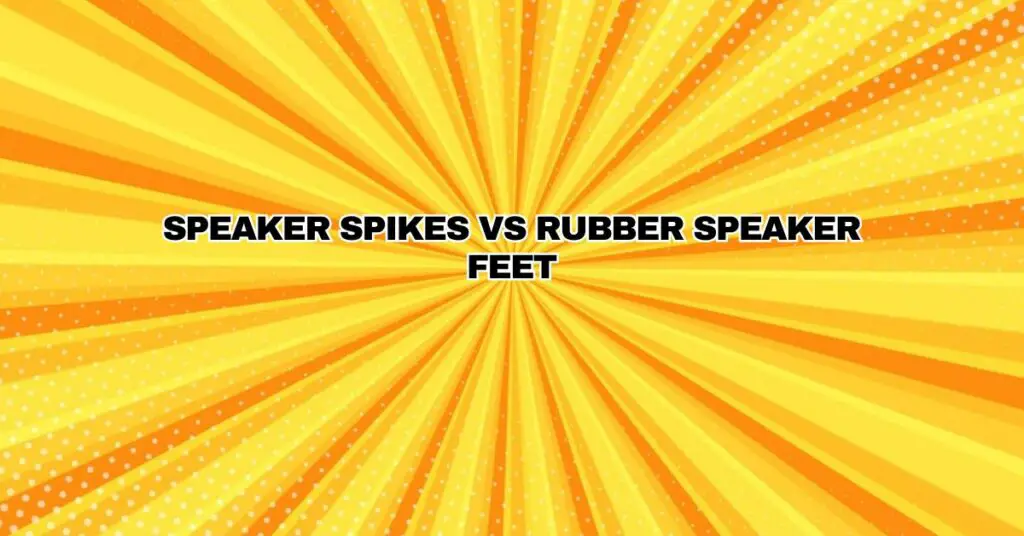The world of audio and sound quality is a realm where even the smallest details can make a significant difference. Among the often-overlooked aspects of speaker setup are the choice of supports beneath them. Speaker spikes and rubber speaker feet are two common options used to enhance sound quality and stabilize speakers. In this comprehensive article, we will delve into the merits, functions, and considerations of speaker spikes and rubber speaker feet, helping you make an informed choice that aligns with your acoustic goals.
The Importance of Speaker Isolation
Before we explore the specifics of speaker spikes and rubber speaker feet, it’s essential to understand why these isolation methods are critical:
- Vibration Control: Speakers generate vibrations when they produce sound. These vibrations can transfer to the floor or other surfaces, causing distortion and affecting sound quality.
- Sound Clarity: Effective isolation helps prevent sound reflections and unwanted vibrations, improving sound clarity and reducing distortion.
- Stability: Both speaker spikes and rubber feet contribute to speaker stability. This ensures that the speakers remain securely in place, reducing the risk of toppling or vibrating off their intended position.
Speaker Spikes: The Precision Solution
Speaker spikes are typically made of metal and are designed to penetrate the floor or stand they rest on. The key advantages and considerations of using speaker spikes include:
1. Vibration Isolation: Speaker spikes effectively reduce vibrations transmitted through the floor, minimizing resonance and maintaining sound quality.
2. Stabilization: Spikes provide a secure and stable base for speakers, even on uneven surfaces.
3. Precise Height Adjustment: Speaker spikes allow for precise height adjustment, enabling you to achieve the ideal listening position.
4. Material Variations: Speaker spikes are available in different materials, such as stainless steel or brass, which can affect the sound and aesthetics.
5. Floor Protection: While they may seem invasive, speaker spikes can prevent scratches or indentations in your flooring.
Rubber Speaker Feet: The Versatile Alternative
Rubber speaker feet, as the name suggests, are typically made of rubber or other elastomeric materials. They offer their unique set of advantages and considerations:
1. Vibration Dampening: Rubber speaker feet absorb vibrations, reducing the transmission of sound energy through the floor or stand. This can improve sound quality.
2. Non-Invasive: Unlike speaker spikes, rubber feet do not penetrate the floor. They provide isolation without causing any damage.
3. Floor Protection: Rubber feet are gentle on flooring materials and help prevent scratches or marks.
4. Easy Setup: Rubber feet are often easier to install than spikes and may not require as much precision during placement.
5. Versatility: Rubber feet can be used on various surfaces, including hard floors, carpet, and stands, making them a versatile choice.
Considerations for Choosing Between Spikes and Rubber Feet
The choice between speaker spikes and rubber speaker feet should be based on your specific needs and acoustic goals. Here are some factors to consider:
1. Flooring Type: The type of flooring in your listening environment plays a significant role. Spikes may be more effective on hard, solid surfaces, while rubber feet are suitable for a broader range of flooring types, including carpets.
2. Acoustic Goals: Consider your acoustic goals. If you aim to minimize vibrations and resonance for optimal sound quality, speaker spikes may be more effective. However, if you prioritize a non-invasive solution that offers some vibration control, rubber feet can be a practical choice.
3. Speaker Type and Weight: The size and weight of your speakers are essential considerations. Heavier speakers may benefit more from speaker spikes due to their greater stability and vibration control.
4. Aesthetics: Both speaker spikes and rubber feet can have an impact on the aesthetics of your speaker setup. Speaker spikes may be more visible and could affect the look of your speakers, while rubber feet are often more discreet.
5. Listening Room: Assess the specific characteristics of your listening room. If you have a dedicated listening room with carefully controlled acoustics, speaker spikes may be more suitable. In contrast, a multifunctional living space might benefit from the versatility and non-invasive nature of rubber speaker feet.
Conclusion: Finding the Right Balance
In the world of audio, there is often no one-size-fits-all solution. The choice between speaker spikes and rubber speaker feet should align with your specific needs and acoustic objectives. Consider the type of flooring, your speaker’s characteristics, and the aesthetics of your setup.
Ultimately, the goal is to enhance sound quality and speaker stability while ensuring that your choice complements your listening environment. Whichever option you choose, the focus should be on achieving audio excellence that resonates with your individual preferences and listening experience.


